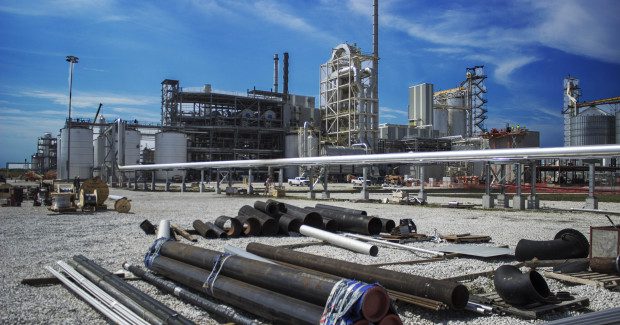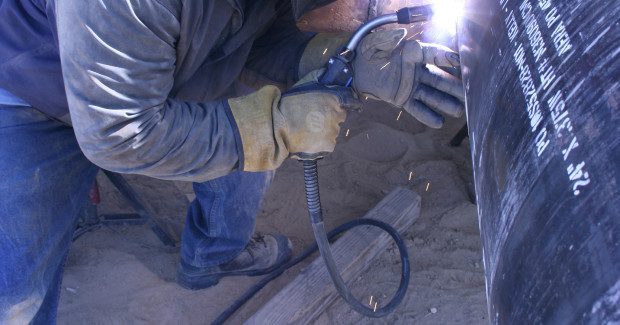How to Meet Critical Deadlines and Improve Safety in the Field
Faced with a growing shortage of skilled labor and demands to complete jobs faster than ever before, contractors must do something to maximize their productivity. What is the answer?
Posted: February 2, 2016
In today’s competitive environment, contractors are being asked to complete projects faster than ever before. Getting the job done as quickly as possible – without sacrificing quality or jobsite safety – is critical. In addition to this pressure to maximize productivity, contractors also face a growing shortage of skilled welding operators, due to both a lack of incoming welding operators and the aging of the current workforce. Finding skilled welding operators to complete work in a timely manner and meet all necessary requirements is a significant issue impacting many industries. Changing welding processes and investing in new technologies can help contractors meet these demands. A conversion to modified short arc and pulsed MIG wire processes can greatly boost productivity and usability for faster welding operator training.
Available remote control welding technologies can also offer benefits that improve productivity and jobsite safety and allow contractors to take on more revenue-generating projects for a significant impact on the bottom line. Labor costs are the majority of the expense associated with welding in the field. Using more productive and forgiving welding processes not only helps contractors save money, it also allows them to complete jobs faster with a broader spectrum of welding operator skill levels. Processes such as Regulated Metal Deposition (RMD®) and pulsed MIG welding can provide significant productivity benefits in the field. These wire processes provide much greater travel speeds and are easy to learn and use, so welding operators can be quickly trained for specific requirements.
In a modified short-circuit MIG process such as RMD, the welding system anticipates and controls the short circuit, and then reduces the welding current to create a consistent metal transfer. Precisely controlled metal transfer provides uniform droplet deposition, making it easier for the welding operator to control the puddle. These processes are also more forgiving to variations in stickout. This results in a calm, stable arc that is easier for operators to control and also makes it easier for less-experienced welding operators to complete quality welds.
Many jobsites, from power plants to petrochemical and refinery projects, are so expansive that welding can take place hundreds of feet from the power source. The need to repeatedly travel the distance from the weld joint to the machine can adversely affect productivity, weld quality and welding operator safety. Solutions include two engine-driven welder/generators capable of remotely controlling and running advanced wire processes in the field. This can be done through the addition of a FieldPro™ Smart Feeder, which can be used 200 ft away from the power source. A Big Blue® 800 Duo Pro SF and a Big Blue 350 PipePro SF are both FieldPro Smart Feeder-compatible.
By connecting the Smart Feeder, all controls shift to the feeder. These controls communicate through the same standard weld cable that carries the welding current from the power source to the feeder, eliminating the need for additional special cabling. This differs from other engine-driven options on the market that require a costly control cable in order to get pulsed MIG capabilities at the weld joint. Eliminating the extra cable results in simplified cable management and less clutter – and saves the cost of having to purchase new control cables or replace ones that have been damaged. This type of remote technology also helps ensure operation even when welders are not in direct line of sight of the power source. The added flexibility comes in handy when welding in tight quarters or enclosed spaces.
Besides reducing the number of time-consuming trips to the power source to make adjustments, these solutions can also impact jobsite productivity in several other ways. The faster travel speeds and higher deposition rates offered by advanced processes allow welding operators to complete code-quality welds in less time. Additionally, productivity gains can be realized by using RMD on the root pass of a pipe joint. Unlike most pipe joints that require a hot pass, the weld bead profile of the RMD process provides the ability to create a thicker root pass of 3/16 in or greater – enough to support the heat input of pulsed MIG or flux-cored welding for the fill passes.
Using a FieldPro Smart Feeder can also reduce setup times due to quick process changeover for MIG, flux-cored and advanced wire processes. Switching from RMD to pulsed MIG also offers time savings, since these processes can typically utilize the same wire and gas. A Big Blue 800 Duo Pro SF model also offers multi-operator benefits that help contractors be more productive with less equipment. Many applications on the jobsite can benefit from the on-board multi-arc welding capabilities, providing added flexibility and versatility. This particular welder/generator provides 800 amps for a single welding operator and 400 amps each for two welding operators. It can also be used as a three-or-more arc multi-operator machine through the use of additional inverter-based welders that can be powered off of the unit’s auxiliary power. In one field example, six welding operators were simultaneously recorded running at a combined 800 amps, with no arc interaction and at 100 percent duty cycle.
Reducing trip and fall hazards on the jobsite is another important consideration. In 2014, the Occupational Safety and Health Administration (OSHA) attributed 874 fatalities (20.5 percent of the overall total) to construction. Of those construction fatalities, falls were responsible for 39.9 percent of the deaths, putting this type of accident atop OSHA’s “Fatal Four” injuries list. Fall protection was also the top OSHA standards violation in 2014. Remote control of welding processes and parameters from the weld joint provides important safety benefits. Jobsites are often large and expansive and have a myriad of obstacles and equipment, which can make maneuverability challenging and hazardous. Reducing the trips a welding operator must make to and from the power source ultimately reduces the chances of a slip and fall accident.
Additionally, eliminating the need for a control cable reduces clutter, which can help improve jobsite safety.
With easy point-of-use control, welding operators don’t have to settle for less-than-optimal settings or try to adjust their technique to accommodate for the wrong parameters. Instead, they can simply adjust voltage and wire-feed speed at the feeder, which helps improve weld quality and reduce rework. Using advanced wire processes, welding operators can achieve essentially the same code-quality welds they have been achieving with stick and TIG welding, but now they can do it with improved deposition rates and travel speeds. Advanced processes also help reduce weld failures and eliminate backing gas on some stainless and chromoly pipe welding applications.
A Big Blue 800 Duo Pro SF and Big Blue 350 PipePro SF are all-in-one units that can be configured to meet the demands and challenges on a wide variety of jobsites. The Big Blue 800 also offers multi-operator benefits, while the Big Blue 350 provides a lighter and more compact engine-driven welder/generator option. Offering complete control at the weld joint without the need for a control cable, a Smart Feeder provides benefits that impact productivity, safety and weld quality, as well as reducing downtime and maintenance costs associated with fragile control cables. The advanced welding processes also provide effective options for operations that are looking for ways to greatly improve efficiency while maintaining weld quality.













